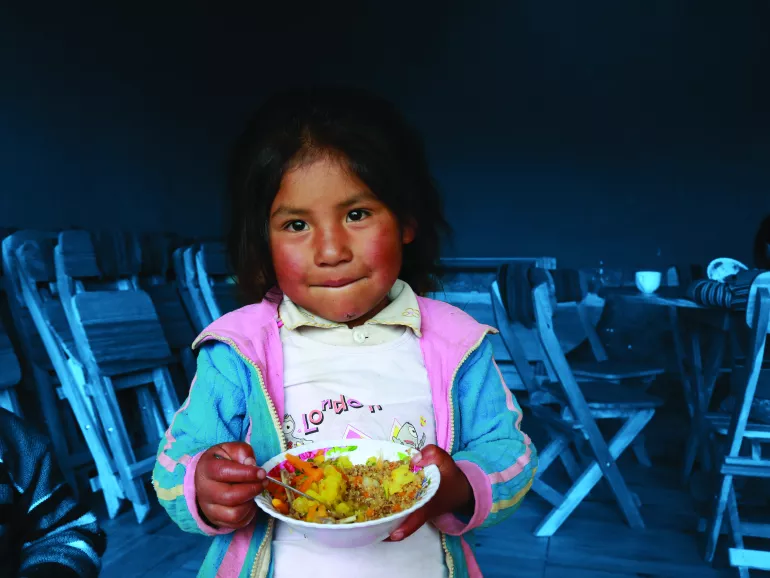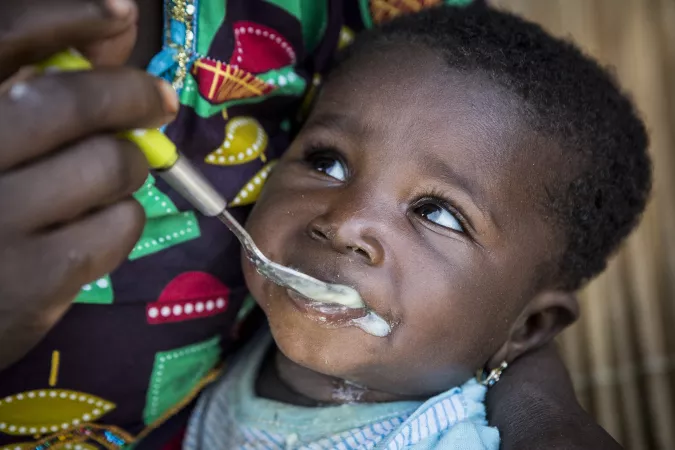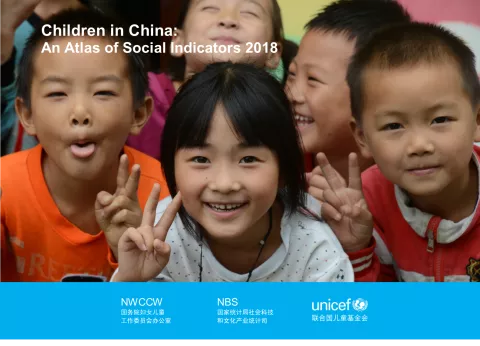Poor diets damaging children’s health worldwide, warns UNICEF
Poverty, urbanization, climate change and poor eating choices driving unhealthy diets 1 in 3 children under five is malnourished; 2 in 3 children under two live on poor diets

- Available in:
- 中文
- English
NEW YORK, 15 October 2019 – An alarmingly high number of children are suffering the consequences of poor diets and a food system that is failing them, UNICEF warned today in a new report on children, food and nutrition.
The State of the World’s Children 2019: Children, food and nutrition finds that at least 1 in 3 children under five – or over 200 million – is either undernourished or overweight. Almost 2 in 3 children between six months and two years of age are not fed food that supports their rapidly growing bodies and brains. This puts them at risk of poor brain development, weak learning, low immunity, increased infections and, in many cases, death.
“Despite all the technological, cultural and social advances of the last few decades, we have lost sight of this most basic fact: If children eat poorly, they live poorly,” said Henrietta Fore, UNICEF Executive Director. “Millions of children subsist on an unhealthy diet because they simply do not have a better choice. The way we understand and respond to malnutrition needs to change: It is not just about getting children enough to eat; it is above all about getting them the right food to eat. That is our common challenge today.”
The report provides the most comprehensive assessment yet of 21st century child malnutrition in all its forms. It describes a triple burden of malnutrition: Undernutrition, hidden hunger caused by a lack of essential nutrients, and overweight among children under the age of five, noting that around the world:
- 149 million children are stunted, or too short for their age,
- 50 million children are wasted, or too thin for their height,
- 340 million children – or 1 in 2 – suffer from deficiencies in essential vitamins and nutrients such as vitamin A and iron,
- 40 million children are overweight or obese.
The report warns that poor eating and feeding practices start from the earliest days of a child’s life. Though breastfeeding can save lives, for example, only 42 per cent of children under six months of age are exclusively breastfed and an increasing number of children are fed infant formula. In China, exclusive breastfeeding for the first 6 months is still very low, at 20.8 per cent. Sales of milk-based formula grew by 72 per cent between 2008 and 2013 in upper middle-income countries such as Brazil, China and Turkey, largely due to inappropriate marketing and weak policies and programmes to protect, promote and support breastfeeding.
As children grow older, their exposure to unhealthy food becomes alarming, driven largely by inappropriate marketing and advertising, the abundance of ultra-processed foods in cities but also in remote areas, and increasing access to fast food and highly sweetened beverages.
For example, the report shows that 42 per cent of school-going adolescents in low- and middle-income countries consume carbonated sugary soft drinks at least once a day and 46 per cent eat fast food at least once a week. Those rates go up to 62 per cent and 49 per cent, respectively, for adolescents in high-income countries.
As a result, overweight and obesity levels in childhood and adolescence are increasing worldwide. From 2000 to 2016, the proportion of overweight children between 5 and 19 years of age doubled from 1 in 10 to almost 1 in 5. Ten times more girls and 12 times more boys in this age group suffer from obesity today than in 1975. In China, childhood overweight and obesity rates have increased significantly during the past decades. From 2002 to 2012, the rates for children under 6 years old increased from 9.2 per cent to 11.5 per cent and for 7-17 years old from 6.6 per cent to 15.8 per cent.
To address this growing malnutrition crisis in all its forms, UNICEF is issuing an urgent appeal to governments, the private sector, donors, parents, families and businesses to help children grow healthy by:
- Empowering families, children and young people to demand nutritious food, including by improving nutrition education and using proven legislation – such as sugar taxes – to reduce demand for unhealthy foods.
- Driving food suppliers to do the right thing for children, by incentivizing the provision of healthy, convenient and affordable foods.
- Building healthy food environments for children and adolescents by using proven approaches, such as accurate and easy-to-understand labelling and stronger controls on the marketing of unhealthy foods.
- Mobilizing supportive systems – health, water and sanitation, education and social protection – to scale up nutrition results for all children.
- Collecting, analyzing and using good-quality data and evidence to guide action and track progress.
“We are losing ground in the fight for healthy diets,” said Fore. “This is not a battle we can win on our own. We need governments, the private sector and civil society to prioritize child nutrition and work together to address the causes of unhealthy eating in all its forms.”
China has made significant progress in improving the health and nutrition of children. A combination of rapid socio-economic development and government initiatives have helped to significantly decrease the prevalence of underweight and wasting children. The national stunting rate reduced from 33.1 per cent in 1990 to 8.1 per cent in 2013. Similarly, anaemia prevalence among children under five went down from 18.8 per cent in 2002 to 10.9 per cent in 2013.
However, undernutrition, hidden hunger, and obesity remain as an unfinished agenda. For example, in 2015, the Global Burden of Disease reported over 15 million obese children and adolescents (2-19) in China. UNICEF is working with the Government of China on the prevention and control of the triple burden of malnutrition (stunting, wasting, and overweight), and the promotion of a healthy food system for children to grow well in a changing world.
For the Chinese version of the Executive Summary of the report, click here.
For the English version of the Executive Summary, click here.
For the English version of the Full Report, click here.
Media contacts
Additional resources
About UNICEF
UNICEF works in some of the world's toughest places, to reach the world's most disadvantaged children. Across 190 countries and territories, we work for every child, everywhere, to build a better world for everyone.
| Visit UNICEF Global website: www.unicef.org Visit UNICEF China website: www.unicef.cn Follow us on Sina Weibo: http://weibo.com/unicefchina Tencent Weibo: http://t.qq.com/unicef Wechat: unicefchina |






